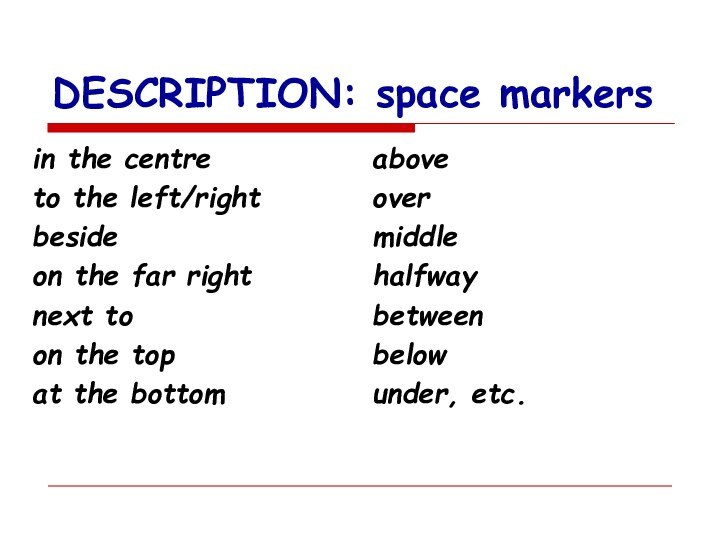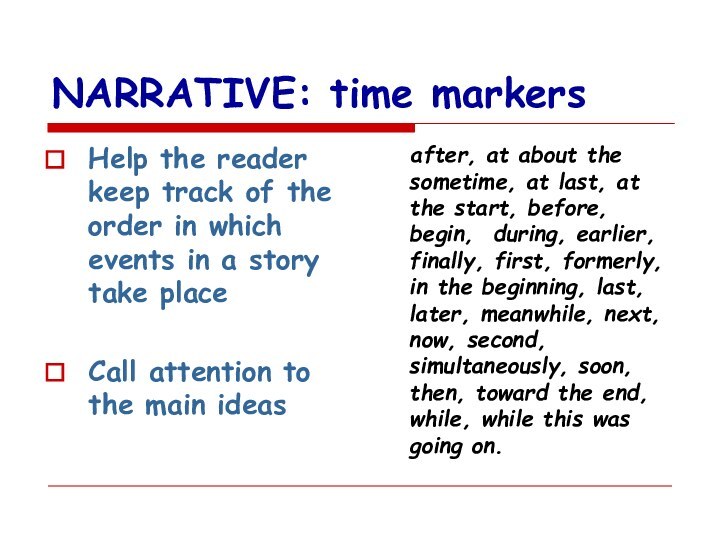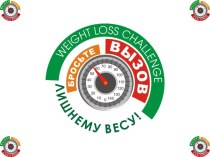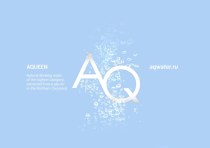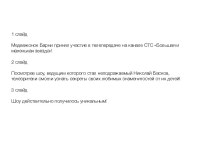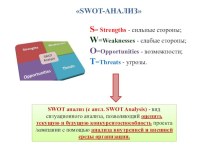Слайд 2
BASIC PATTERNS OF THOUGHT DEVELOPMENT
Specific patterns
PROCESS
(How something works)
NARRATIVE (How something happened)
DESCRIPTION (How something/someone appears)
COMPARISON
(How two things are alike/different)
CAUSE AND EFFECT (How one thing affects something else)
PROBLEM SOLUTION (How a problem can be solved)
CLASSIFICATION (How something can be categorised)
ARGUMENTATION (How a position or an opinion can be asserted and supported)
DEFINITION (How to explain or to make something clear and distinct)
Слайд 3
DESCRIPTION
Description is painting pictures in words
Use your five
senses: see, hear, feel, taste, and smell give a
description of the apple.
Use: figures of speech: metaphors, similes, personifications.
Vocabulary: fruit, shape (oval, round), taste (sweet, sour), feel (hard, smooth), colour (green, red, pink, yellow), ripe, juicy.
Grammar focus: 1) link/copular verbs + Adj. 2) Degrees of Comparison (adjectives, adverbs)
Слайд 4
DESCRIBING RULES
1. Before you describe sth: ask, “Why
is it unique? What makes it special?” Focus your
description on these details.
2. Be specific/ Choose exact, precise words: complain instead of say, cottage/manor/block of flats instead of house, etc.
3. Use vivid words to describe: scarlet instead of red, thoughtful instead of nice, etc.
4. Use words that appeal to human senses: see, hear, smell, feel, taste
Слайд 5
DESCRIPTION: space markers
in the centre
to the left/right
beside
on the
far right
next to
on the top
at the bottom
above
over
middle
halfway
between
below
under, etc.
Слайд 6
DEFINITION
Definition – stating the meaning;
making definite, distinct, or clear
Use your previous
life experience and give a definition of the apple.
Name:
type/class/category
main characteristics and features
properties and peculiarities
qualities
family
conditions (of existence, living, growing, etc)
surrounding /environment
usage, etc.
Слайд 7
DEFINITION: add-ons
Terms that let us know that
other important facts or details are coming.
Add-ons signal
us to look for main ideas.
also, and, another, besides, for example, for instance, further, furthermore, in addition, (even) more important, moreover, more than that, too, similarly, specially
Слайд 8
NARRATIVE
Narrative is writing that relates an
event or a series of events (a story or
an account)
Tell how the apple turned to be here.
Use your imagination and previous experience.
Pay attention to the order of events and sequence.
Слайд 9
NARRATIVE: time markers
Help the reader keep track of
the order in which events in a story take
place
Call attention to the main ideas
after, at about the sometime, at last, at the start, before, begin, during, earlier, finally, first, formerly, in the beginning, last, later, meanwhile, next, now, second, simultaneously, soon, then, toward the end, while, while this was going on.
Слайд 10
CLASSIFICATION
Classifying is placing items
in a group because they are similar or alike
Give your classification according to different principles. Group things according to size, shape, weight, or colour, etc.
Слайд 11
INSTRUCTIONS (process)
Instructions are steps to follow in order
to make
Explain how to do something in a clear
and sensible way
Help us bake bread, take a test, or build a bookcase
Слайд 12
DIRECTIONS (process)
Directions are steps to follow
in order to go somewhere / or to get
from one place to another
Help to travel to a new place
Need to be complete, yet clear and easy for the listener
Слайд 13
GUIDELINES to instructions
Be as clear, exact, and brief
as possible.
Give each step in the right order.
Tell the
person what to do first, second, and so on.
Use time-order words like next, after, now, soon, last.
Слайд 14
COMPARISON and CONTRAST
Comparison is using examples to show
how things are similar and different, with the greater
emphasis on similarities
Contrast is using examples to show how things are different in one or more important ways.
Слайд 15
COMPARISON and CONTRAST: both-sides signals
Change the ideas in
a sentence
Tell you that the ideas in the
second part of the sentence will be different from those in the first part
Call attention to the ideas that come before them
although, anyhow, besides, but, by contrast, despite, even though, however, in fact, in particular, instead, nevertheless, on the other hand, yet, etc.
Слайд 16
ARGUMENTATION
Argumentation is presenting reasons or arguments in a
logical way.
Persuasion is prevailing on a person to do
something by advising or urging
Give your personal point of view.
Слайд 17
ARGUMENTATION:
signal words
Pointers are signal words
or phrases that indicate important points or main idea:
chief, chiefly, especially, mainly, most, most important, primarily, principal, principally etc
Слайд 18
ARGUMENTATION:
signal words
Summarisers and concluders are
signal words and phrases that help us bring together
thoughts that form main ideas:
apparently, as a result,
clearly, consequently, in conclusion, in effect, obviously, so, therefore, thus, we can see, we have demonstrated, we have shown, etc.
Слайд 19
PROBLEM-SOLVING
Main steps
The problem is recognised and stated.
Possible solution
is suggested.
The steps in solving the problem are given.
There
is proof that the solution is a good one.
Слайд 20
BEFORE WRITING
Think about the reason for writing. That
is our purpose.
Why are we writing?
To tell a story? To persuade someone about an opinion we have? To explain how to do something?
Think about who will read. That is our audience.
Who will read what we write? Will our reader be someone of our own age/younger/an adult? Consider your audience when you speak or write.
Think about the style: formal/informal language.
What form will you use (letter, article, essay)?
Слайд 21
REFERENCE
Richard F.Bandlow, Evart High School, Joan Kimball Yehl,
Central Michigan University, Writer’s Guide. Newsweek , Inc., the
USA.
Don L. Wulffson, The Basics of Writing. Globe Book Company Inc., the USA.
Adventures in American Literature. Curriculum and Writing. Francis Hodgins, University of Illinois, Kenneth Silverman, New York University. Harcourt Brace Jovanovich, Publishers, the USA.
Wink, Diane M. (1993).Using Questioning as a Teaching Strategy. Nurse Educator.
Patrek Sebranek, Verne Meyer, and Dave Kemper, Write for College (A student Handbook), Write Source/ Great Source Education Group, a Houghton Mifflin Company, Wilmington, Massachusetts.




